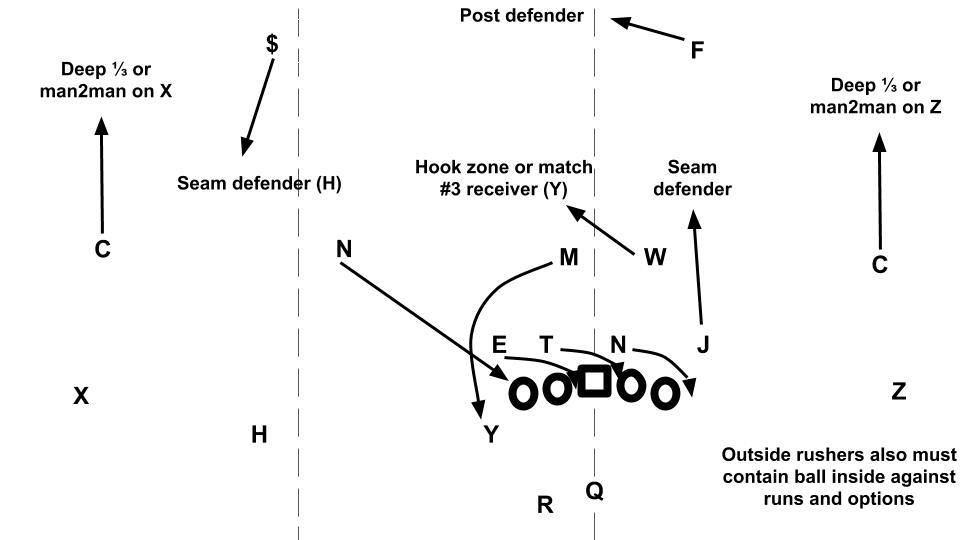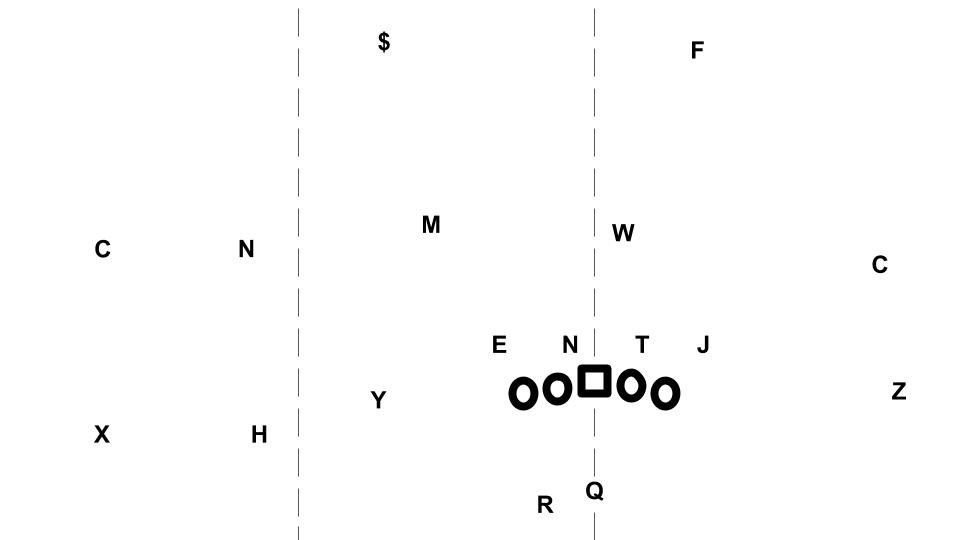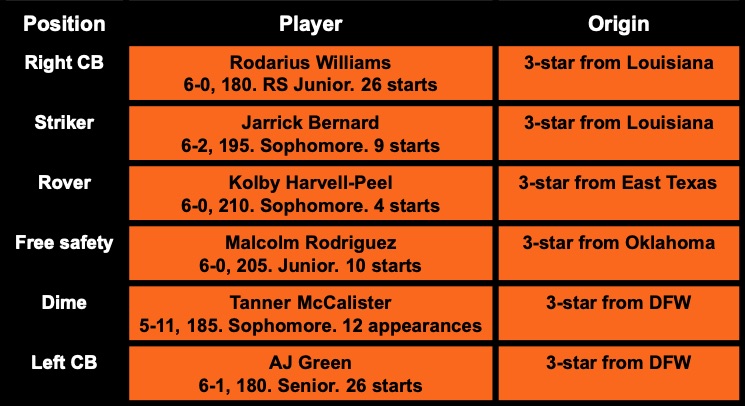The zone blitz is immensely difficult to rely on as a strategy in the Big 12. There have been a number of defensive coaches that came into the Big 12 with a background in utilizing the most cutting edge from zone blitz world only to fall upon hard times.
Some notables:
Manny Diaz who took over an experienced Will Muschamp D in 2011 and produced one of the best units the league has seen this decade, then lost several of his starters and was fired two games into the 2013 season.
Charlie Strong who took over Texas after Mack Brown stepped down and had early success in 2014 with another top unit but mostly from being able to drop eight behind a DL that went Cedric Reed (10 TFL, 5.5 sacks), Hassan Ridgeway (10 TFL, six sacks), and Malcom Brown (13 TFL, 5.5 sacks). In subsequent seasons without that star power up front or the other departing seniors the Longhorns completely unraveled on defense.
Todd Orlando, Strong’s successor, also had more success in his first year deploying upperclassmen and leaning on drop eight coverages behind a three-man DL before circling back to his preferred pressures in year two and running into problems.
Matt Rhule, the Baylor head man who has yet to figure out how to translate his preferred defensive scheme into something that Baylor’s roster can execute against the Big 12.
Jim Knowles, who got more aggressive once freed up under Mike Gundy rather than working for the more conservative David Cutcliffe. The Cowboys got really zone-blitz happy a year ago, bringing the full gamut of overloads and simulated pressures that everyone loves as well as some other tricks, and finished tied for 10th nationally with 39 sacks.
Jordan Brailford led the way with 10, Jarrell Owens added six, and 13 other players got in on the action. Of course for all that, the Cowboys finished 71st in defensive S&P+ thanks to a 111th place finish in the IsoPPP measurement that captures the explosiveness of the offense. That’s what we call a “boom or bust” defense and that’s been typical of zone blitz practitioners in the Big 12.
Also notable, eight of Brailford’s 10 sacks in 2018 came against Missouri State (1), South Alabama (1), Boise State (3), or Kansas (3). The difference between getting home or watching the QB hit a receiver in space is more or less the difference between the Big 12 and every other league.
The keys to the zone blitz
The fire zone blitz that still has a ton of purchase around the game is still defined by bringing five rushers, having three underneath defenders, and then three deep defenders. In the world of spread-option, RPO offenses things have had to be tweaked over time so that most everyone now plays man coverage or match-3 on their fire zones.

There are a few crucial ingredients to making this recipe work. The most important is CBs that can play alone outside with no help except (maybe) underneath on curl routes from the seam defenders and (supposedly) help on the post route from the deep safety. Then you need smart and quick defenders in the underneath zones that can match their routes properly and won’t get shredded by quick routes to slot receivers flooding a zone or crossing underneath. Like with any other anti-spread scheme, it behooves you to be small and fast at most positions in the backfield to make it work.
Finally, the DL need to be pretty quick and mobile as well because they are often slanting and long-sticking across gaps and need to be able to fit gaps if it’s a run and otherwise hold the attention of the OL so that the blitzers you’re choosing from a collection of lighter and quicker backfield defenders can blast through windows.
The match-3 versions of the blitz are best because it gives defenses the opportunity to “switch screens” so to speak if offenses throw difficult route combos at them. They’re also tricky though, so teams often just play man-1 blitzes where everyone underneath just relates to a specific receiver (1 from the sideline for CBs, 2 from the sideline for OLBs/Ss, etc). Here’s OK St playing a man-1 blitz and still blowing an assignment against motion:
I’m guessing the late blitzing ILB was supposed to relate to the RB and lost him somehow. Now everyone else has their back turned to the ball or is running to the QB as fast as they can. Don’t even ask about what happens against the QB run game if the blitz doesn’t blow up the play. QB run game with a RPO to a swinging RB? Yikes.
The other issue with these blitzes is in facing a spread offense. For instance:

Who’s playing coverage on the Y receiver here? And keep in mind that’s often where teams stick their best receiver on a key passing down. There’s not many options for who is even in position to cover him and overall not a lot of variation in the blitzes that the defense can create from this look. To have a chance at confusing the OL and QB about who’s coming and who will get what matchups is to start subbing out defenders for hybrids. That DE next to the Y for instance, you want an OLB there to breath life back into the zone blitz, or another safety at MLB.
The best way to execute any variety of 5-man pressure, match-3 or man-1, is to have loads and loads of smart, experienced, and versatile defenders in the middle of the field. Otherwise the spread starts to simplify the picture for the QB and give the offense pitch and catch opportunities.
The X-backer and OSU secondary in 2019
In 2019, OSU will be in as good a shape as they’ve been since 2013 to execute an effective defense built around fire zones or other five-man pressures. Here’s a snapshot of their secondary heading into the year:

As you can surmise, they took their lumps last year with a young group inside and now bring back several guys who are either returning starters or played a ton in Big 12 games. Their “striker” safety is just a nickel and tends to be a little more coverage oriented. The rover plays in between the striker and the free safety in what I typically label as the strong safety ($) in diagrams like the one above.
The Cowboys have a number of guys who have a year in the scheme now as well as a pair of corners in Green and Williams that can hold up as well as most teams’ guys without help over the top. If you were drafting a team’s cornerback roster to build the ultimate Big 12 unit, OSU’s tandem would probably go third after TCU and Texas.
If Knowles can get these guys up to speed in match coverage then OSU could play a lot of nickel and dime next season and be able to bring some real disguise to their coverages and blitzes because so many defenders on the field will be credible in coverage on a slot.
The other trick Knowles showed in 2018 they OSU could use more in 2019 is the X-backer. I got that terminology from Blitzology.com, I’ve seen other teams use the term “spinner,” but the idea is the same. It’s a stand-up pass-rusher who moves around and blitzes from different spots, typically a DE/OLB-type and it’s where Brailford got to play a lot last year.
You see Brailford start in the B-gap before looping outside to his preferred trajectory off the edge. This ends up as a 5-man pressure but only because the MLB sees the RB commit to run blocking and then joins the party, the WLB ends up cleaning up the play and getting the sack but he was playing coverage until Will Grier decided to tuck and run. So really this is a base 4-man blitz with some of the effects of a blitz because Brailford has some freedom to move around and be the 4th rusher from a variety of angles.
This approach can get you into some trouble against the run at times, for instance…
That official got maybe the best hit on Kennedy McKoy all day, dude turned 21 carries into 148 yards at seven per pop with two TDs. Brailford is timing the snap off the edge but Cal Bundage gets over zealous and the DTs get totally swallowed up.
For this coming season the Cowboys have a couple of solid options a X-backer. There’s Brock Martin, who played there some a year ago and is next in line at DE, and then JUCO Mike Scott who had three sacks last year in spot duty, including this traditionally acquired edge rush.
Between those two the Cowboys have good options either for utilizing the X-backer again or even utilizing a 2-4-5 deal with either JUCO Mike or Martin playing standing up.
OSU has a lot going for them in 2019, the offense has some of the best skill players (the best?) in the conference along with some experience on the OL, some TEs, options at QB, and then the aforementioned assets on defense. The season probably hinges on whether Jim Knowles can figure out to maintain lethality in their pressure packages without giving away big plays to Big 12 offenses. Their use of the X-backer and how they approach blitzing with a much more experienced collection of safeties in the middle of the field will tell the story of their season.





Daily Bullets (June 27): Boynton Filling Out His Bench - Big 12 Blog Network
[…] Jim Knowles, who got more aggressive once freed up under Mike Gundy rather than working for the more conservative David Cutcliffe. The Cowboys got really zone-blitz happy a year ago, bringing the full gamut of overloads and simulated pressures that everyone loves as well as some other tricks, and finished tied for 10th nationally with 39 sacks. [Concerning Sports] […]
Do ISU and Texas not use zone blitzes?
Texas does, that was mentioned in the article.
Iowa State likes to bring trap-2 fire zones (four-under/two-deep) and they have some of those Narduzzi-type blitzes as well (two-under/three-deep). Their main strategy though is to drop eight into coverage and when they do fire off the blitzes their dime structure gives them a lot more flexibility in how they do it, plus they still leave two deep as often as not.
Texas likes the fire zone and the simulated pressure but it didn’t work out so hot for them last year and they ranked near the bottom of the league on third down.
My preseason All-B12 ballot – Concerning Sports
[…] Wallace with all kinds of interesting role players around them like Jelani Woods and Dillon Stoner. It’s all about whether Jim Knowles can build a good defense from a solid secondary. That’s a big question but there are bigger ones […]